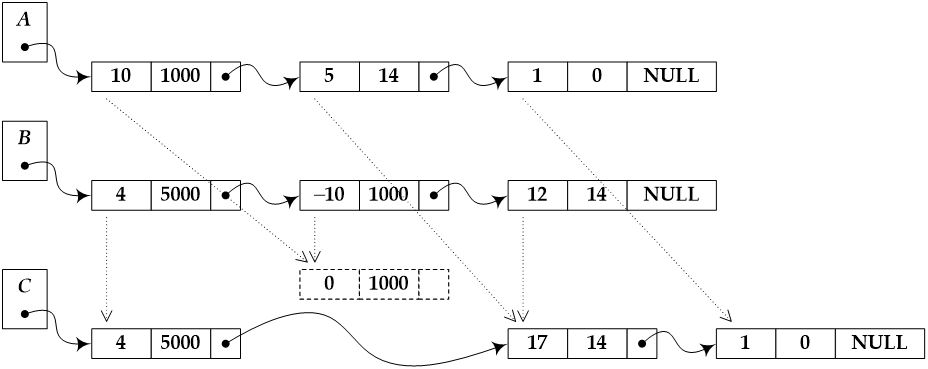
前言
使用表的时候,我们有一个非常常见的问题——多项式ADT,即用表来解决关于一元多项式的抽象数据类型。
我们现在要使用表来对一元多次方程进行操作,例如加减法和乘法。
一元多次方程形如:
接下来就是使用数组(线性表)和链表的解决。
数组实现
我们使用数组实现的话,我们可能需要处理的是系数(coefficient)和指数(exponent),我们很容易想到的是使用二维数组来存储。但是当系数或指数比较大的时候,二维数组所占用的空间过多,所以不是一个合适的解法。
那如果使用数组的下标表示指数,然后数组存储系数的话,或许是个可行的方法。并且时间复杂度也随之下降。
为了表示系数和指数的关联,我们使用结构体来定义这个数组和记录它的最高次幂。
#define MaxDegree 100//MaxDegree记录允许的最大幂typedef struct poly_array{ int CoeffArray[MaxDegree+1]; //store the coefficients int HighPower; //表示当前方程的最高次幂,小于等于MaxDegree}*poly;接下来就是对这个数组进行一些初始化了,如全部初始化为0先:
void zeropoly(poly p){ p->HighPower=0; //当前没有东西,最高次为0 for(int i=0;i<=MaxDegree;i++) p->CoeffArray[i]=0;}加法
接下来的内容是实现多项式加法,这个比较简单。根据我们数学知识,多项式加法,同次幂的系数相加,若没有同次幂的情况,则保留即可。

因为我们是以最大次项作为循环的标志来操作数组的,所以需要考虑一个特殊情况:如果最高次项相加为0——这种情况下该项就不存在了,最高次项就应该发生转移。解决这个问题需要我们在循环中时刻警惕更新最大次幂的值。
故总的来说,加法需要考虑如下情况,我们设两个多项式分别为p1,p2,在指数为i时:
- p1->coeffarray[i] ≠ 0 , p2->coeffarray[i] == 0,此时p1存在项,p2不存在,我们得到的sum->coeffarray[i] = p1->coeffarray[i];
- p1->coeffarray[i] == 0 , p2->coeffarray[i] ≠ 0,此时p2存在项,p1不存在,我们得到的sum->coeffarray[i] = p2->coeffarray[i];
- p1->coeffarray[i] ≠ 0 , p2->coeffarray[i] ≠ 0,此时p1,p2均存在项,我们得到的sum->coeffarray[i] = p1->coeffarray[i] + p2->coeffarray[i];
- p1->coeffarray[i] == 0 , p2->coeffarray[i] == 0,此时p1,p2均不存在项,我们得到的sum->coeffarray[i] = 0;
- p1->coeffarray[i] ≠ 0 , p2->coeffarray[i] ≠ 0, p1->coeffarray[i] + p2->coeffarray[i] ==0,此时p1,p2均存在项但和为0,我们得到的sum->coeffarray[i] = 0; 此时我们的这一项不应该是最高次项。
所以我们就有这样的函数:
poly poly_addition(const poly p1, const poly p2){ poly sum=(poly)malloc(sizeof(struct poly_array)); zeropoly(sum); int power=max(p1->HighPower,p2->HighPower); for(int i=power;i>=0;i--) if(p1->CoeffArray[i] || p2->CoeffArray[i]) //if terms need to add sum->CoeffArray[i]=p1->CoeffArray[i]+p2->CoeffArray[i]; for(int i=power;i>=0;i--) //refind the highest power of sum if(sum->CoeffArray[i]) sum->HighPower=i,break; //the first none-zero if the highest power. return sum;}代码中power取到了两个多项式的最高项,可以确定我们相加的范围;综合前面的情况,如果不是均为0的情况,我们直接将当前次数的两多项式系数相加即可。(当然均为0也可以相加,但是会多执行很多次操作。)
最后一个循环是在找新生成的多项式中的最高指数,因为存在之前第五种可能的情况,此时不一定是我们之前找到的power,它的最高指数一定是<=power的,故我们重新开始找,找到第一个不是0的指数就是我们要找的最高指数了。
减法
减法和加法一样,或者说减法就是加法的一种情况,所以情况和代码也基本相同。
减法需要考虑如下情况,我们设两个多项式分别为p1,p2,减法为p1-p2,在指数为i时:
- p1->coeffarray[i] ≠ 0 , p2->coeffarray[i] == 0,此时p1存在项,p2不存在,我们得到的sum->coeffarray[i] = p1->coeffarray[i];
- p1->coeffarray[i] == 0 , p2->coeffarray[i] ≠ 0,此时p2存在项,p1不存在,我们得到的sum->coeffarray[i] = **-**p2->coeffarray[i];
- p1->coeffarray[i] ≠ 0 , p2->coeffarray[i] ≠ 0,此时p1,p2均存在项,我们得到的sum->coeffarray[i] = p1->coeffarray[i] - p2->coeffarray[i];
- p1->coeffarray[i] == 0 , p2->coeffarray[i] == 0,此时p1,p2均不存在项,我们得到的sum->coeffarray[i] = 0;
- p1->coeffarray[i] ≠ 0 , p2->coeffarray[i] ≠ 0, p1->coeffarray[i] - p2->coeffarray[i] ==0,此时p1,p2均存在项但和为0,我们得到的sum->coeffarray[i] = 0; 此时我们的这一项不应该是最高次项。
故代码为:
poly poly_subtraction(const poly p1, const poly p2){ poly sum=(poly)malloc(sizeof(struct poly_array)); zeropoly(sum); int power=max(p1->HighPower,p2->HighPower); for(int i=power;i>=0;i--) if(p1->CoeffArray[i] || p2->CoeffArray[i]) //if terms need to subtract sum->CoeffArray[i]=p1->CoeffArray[i]-p2->CoeffArray[i]; for(int i=power;i>=0;i--) if(sum->CoeffArray[i]) sum->HighPower=i,break; //the first none-zero if the highest power. return sum;}和之前加法的代码基本相同,这里就不再解释。
乘法
多项式的乘法满足逐项相乘后相加的特点——逐项相乘并相加,相乘时系数相乘,指数相加,例如:

根据乘法法则,对于 这一项,它与第二个多项式逐项相乘并相加: ,然后再对 这一项逐项相乘并相加,再到2这一项。
所以很容易看出来,我们通过计算机处理它应该使用两重循环,第一层循环处理第一个多项式的第i项,第二层循环处理第二个多项式的第j项。然后逐项相乘并相加即可。
相乘时,我们生成的系数应该存在product->coffarray[i+j]处,因为系数相乘,指数相加。
同样的,它同样也会出现一些情况,我们设两个多项式为p1,p2,在i,j下:
- p1->coeffarray[i] ≠ 0 , p2->coffearray[j] == 0,此时p1存在项,p2不存在,我们得到的product->coeffarray[i+j] = 0;
- p1->coeffarray[i] == 0 , p2->coeffarray[j] ≠ 0,此时p2存在项,p1不存在,我们得到的product->coffarray[i+j] = 0;
- p1->coeffarray[i] ≠ 0 , p2->coeffarray[j] ≠ 0,此时p1,p2均存在项,我们得到的product->coeffarray[i+j] = p1->coeffarray[i] - p2->coeffarray[i];
- p1->coeffarray[i] == 0 , p2->coeffarray[j] == 0,此时p1,p2均不存在项,我们得到的product->coeffarray[i+j] = 0.
此时不存在两项非0相乘为0的情况,但是因为乘法法则,指数相加了,所以还需要我们重新找一次最高指数。
故代码为:
poly poly_mutiplication(const poly p1, const poly p2){ poly product=(poly)malloc(sizeof(struct poly_array)); zeropoly(product); for(int i=0;i<=p1->HighPower;i++) { for(int j=0;j<=p2->HighPower;j++) { if(!(i + j > MaxDegree)) //Determine whether the size is exceeded { product->CoeffArray[i+j] += p1->CoeffArray[i]*p2->CoeffArray[j]; } else { printf("Out of size!\n"); return NULL; } } } for(int i=p1->HighPower + p2->HighPower;i>0;i--) //find the highest power of product if(product->CoeffArray[i]!=0) product->HighPower=i,break; //first none-zero coeffcient power is the highest.}代码中循环我们先判断当前生成的指数i+j会不会超过限制,超过限制了就不能相乘了。注意相乘时,我们应该是product->coeffarray**+=**…因为可能相乘会出现同样指数的项,我们需要把它们合并相加,不能直接覆盖了,所以必须是+=。
最后重新查找时,我们假设从最大可能位置开始找,找到第一个系数不为0的即最大指数。
但是我们试想一下,如果最高指数与后面的指数相差很多,例如 这种,我们就需要生成一个1000+1个位的数组,其中只用到了很少的空间,造成了空间浪费。
因为数组是连续的,如果换成不连续的链表就可以节省很多空间。
链表实现
和数组一样的,我们也需要存储系数和指数,我们使用单向链表还需要一个指向下一项的指针。故定义:
typedef struct poly_linked{ int coefficient; int exponent; struct poly_linked *next;}*poly,Node;接下来也是对链表的初始化和其他函数,默认传进来的数组是已经递减排序的:
poly createpoly(int *arr, int n) //arr must exponentially decreasing!{ poly p=(poly)malloc(sizeof(Node)); //p为哑节点,p->next的为head poly t=p; for(int i=n;i>0;i--) { if(arr[i] != 0) //如果存在项 { t=insert(t,arr[i],i); //把当前插入,并且将其设为前节点 } } return p;}
poly insert(poly t,int c,int e) //t是前节点,因为需要单向链表连接{ poly node=(poly)malloc(sizeof(Node)); if(node == NULL) {printf("No Space!\n");return NULL;} node->coefficient=c; node->exponent=e; node->next=NULL; if(t!=NULL) t->next=node; //连接 return node; //返回新的节点}
int max(int x,int y){ return (x>y)?x:y;}
poly find_exp(poly t, int e) //找到指数为e的节点,并返回{ while(t) { if(t->exponent == e) return t; t=t->next; } return NULL;}加法
使用链表时,两个多项式不一定是项相对的。我们在链表加法中,应该是如图所示的做法:

即找到相同指数,并且系数相加;没找到则保留。因为我们是从大到小创造链表了,所以在两个位置t1,t2上(多项式p1,p2)的时候,存在下面的情况:
- 如果t1->exponent == t2->exponent时,说明这两个位置上的指数相同,我们把它们相加。
- 如果t1->exponent > t2->exponent时,说明当前位置下,t1的指数比t2的指数大,因为是递减的,说明p2中不存在与t1这样大的指数了,故此时我们把t1加入。
- 如果t1->exponent < t2->exponent时,说明当前情况下t1的指数比t2小,在之后p1中也不会存在大于等于t2的情况,故此时把t2加入。
故此时我们的代码就分三种情况即可:
poly poly_addition(poly p1, poly p2){ poly t1=p1,t2=p2; poly sum=(poly)malloc(sizeof(Node)); //sum has dumb node. sum->next=NULL; poly t3=sum; //record preview node of sum while(t1 && t2) { if(t1->exponent == t2->exponent) //Counterpoint { int count=t1->coefficient + t2->coefficient; if(count != 0) //avoid count==0 => no need to store { t3=insert(t3,count,t1->exponent); } t1=t1->next;t2=t2->next; continue; } if(t1->exponent > t2->exponent) //Dislocation 1: t1 have and t2 haven't { t3=insert(t3,t1->coefficient,t1->exponent); //must exist t1=t1->next; //移动t1 continue; } if(t1->exponent < t2->exponent) //Dislocation 2: t2 have and t1 haven't { t3=insert(t3,t2->coefficient,t2->exponent); //must exist t2=t2->next; //移动t2 continue; } } return sum->next;}这里当它们对位相加的时候,要注意可能出现相加为0的情况,这个时候就不需要存储了。
我这里返回sum->next,是因为sum为哑节点,前面调用都是从它的下一位,即head开始的,故这里返回head。当然你也可以自己改。
减法
和加法一样的,同样是三种情况:
在两个位置t1,t2上(多项式p1,p2)的时候,存在下面的情况:
- 如果t1->exponent == t2->exponent时,说明这两个位置上的指数相同,我们把它们相减。
- 如果t1->exponent > t2->exponent时,说明当前位置下,t1的指数比t2的指数大,因为是递减的,说明p2中不存在与t1这样大的指数了,故此时结果为t1。
- 如果t1->exponent < t2->exponent时,说明当前情况下t1的指数比t2小,在之后p1中也不会存在大于等于t2的情况,故此时结果为0-t2。
和加法一样,我们也要主要相减等于0的情况:
poly poly_subtraction(poly p1, poly p2){ poly t1=p1,t2=p2; poly sum=(poly)malloc(sizeof(Node)); //sum has dumb node. sum->next=NULL; poly t3=sum; //record preview node of sum while(t1 && t2) { if(t1->exponent == t2->exponent) //Counterpoint { int sub=t1->coefficient - t2->coefficient; if(sub != 0) //avoid sub==0 => no need to store { t3=insert(t3,sub,t1->exponent); } t1=t1->next;t2=t2->next; continue; } if(t1->exponent > t2->exponent) //Dislocation 1: t1 have and t2 haven't { t3=insert(t3,t1->coefficient,t1->exponent); //must exist t1=t1->next; continue; } if(t1->exponent < t2->exponent) //Dislocation 2: t2 have and t1 haven't { t3=insert(t3,0-t2->coefficient,t2->exponent); //must exist t2=t2->next; continue; } } return sum->next;}乘法
乘法根据乘法律,我们也是逐项相乘,然后化简。于是当我们相乘的时候,要讨论两种情况:
- 结果中已经存在当前相乘得到的指数,此时我们把它们相加;
- 结果中不存在当前得到的指数,我们新创建node。
故此时代码:
poly poly_multiplication(poly p1, poly p2){ poly p=p1,q=p2; poly product=(poly)malloc(sizeof(Node)); //product has dumb node. product->next=NULL; poly pre=product; //record preview node of product while(p) { while(q) { //Find if a result with the same exponent already exists before poly found=find_exp(product->next,p->exponent+q->exponent); if(!found) //No find, create { pre=insert(pre,p->coefficient*q->coefficient,p->exponent+q->exponent); } else //Merge the results of the same exponent { found->coefficient+=p->coefficient*q->coefficient; } q=q->next; } p=p->next; q=p2; } return product->next;}但是此时可能会出现乱序的问题,因为我们不能保证新相乘得到的指数一定是递减的,故可能需要给这个新的多项式进行排序。例如: ,其中第一项指数为4,第二项指数为5,此时4<5,已经乱序了。
对于重新排序多项式,我们只需要使用类似冒泡排序之类的就可以解决了。
poly poly_sorting(poly p){ poly t1=p; poly t2=p->next; while(t1) //类似冒泡排序 { while(t2) { if(t1->exponent < t2->exponent) { poly t=find_pre(p,t1->exponent); //preview node of t1 t->next=t2; t1->next=t2->next; t2->next=t1; } t2=t2->next; } t1=t1->next; } return p;}
poly find_pre(poly p, int e) //找到前节点{ poly t=p; while(t) { if(t->next->exponent == e) return t; else t=t->next; } return NULL;}后记
多项式算法就到这里结束了,仅为个人代码,如有出错请告知!

